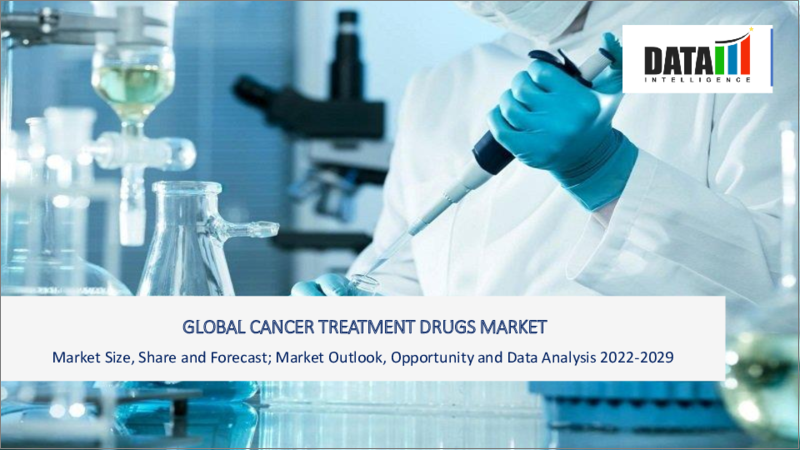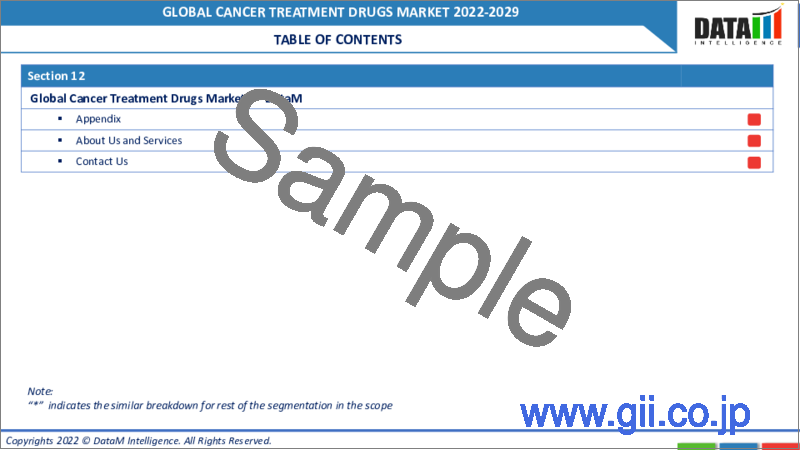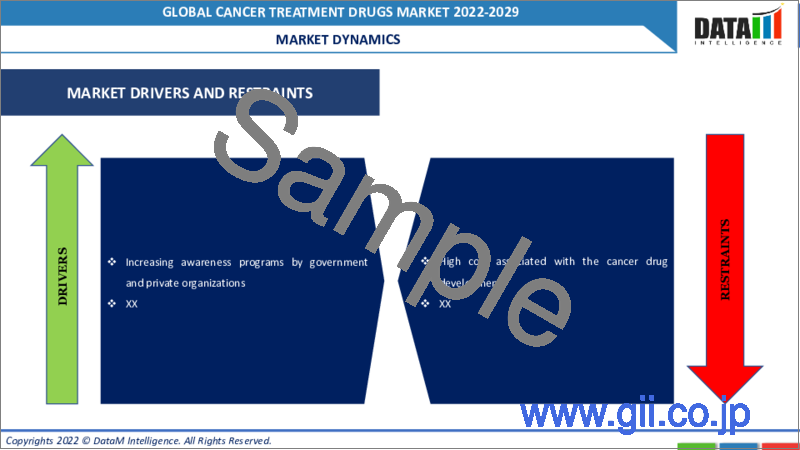|
|
市場調査レポート
商品コード
1138301
がん治療薬の世界市場-2022-2029Global Cancer Treatment Drugs Market - 2022-2029 |
||||||
|
● お客様のご希望に応じて、既存データの加工や未掲載情報(例:国別セグメント)の追加などの対応が可能です。 詳細はお問い合わせください。 |
|||||||
| がん治療薬の世界市場-2022-2029 |
|
出版日: 2022年10月18日
発行: DataM Intelligence
ページ情報: 英文 170 Pages
納期: 約2営業日
|
- 全表示
- 概要
- 目次
市場力学
政府・民間団体による啓発活動の活発化が市場成長の原動力となる見込み
政府および民間組織による啓発プログラムは、乳がんに対する人々の診断の意識を高めるのに役立ち、市場成長の原動力となります。乳がんに関する認知度は低く、女性はその種の感染症について話すことをためらっていました。政府の取り組みによる意識向上プログラムの数は、乳がん診断率を向上させるのに役立ちます。したがって、乳がんの早期診断は、乳がんを治すのチャンスを向上させるのに役立ちます。また、治療もより効果的に行うことができるため、予測期間中の市場にも貢献します。NBCF(全米乳がん財団)は、全米マンモグラフィープログラムのもと、米国やその他の国の女性に無料のマンモグラフィーを提供し、無料の乳がん教育を提供することで世界中の人々を支援しています。この組織は、乳がんに関する重要な資料を提供し、女性が自分の体について教育することで、健康をコントロールする力を与えています。個人的なトレーニングセッション、イベント資料、オンライントレーニングモジュールなどが含まれます。NCBFは他の団体と提携し、全国のコミュニティの女性たちに乳がん教育や乳がんの早期発見を提供しています。
さらに、がん治療の研究開発が、予測期間中の市場成長を後押ししています。例えば、2020年7月、米国国立がん研究所(NCI)は、予防、発見、治療に関する理解を深めるために、膵臓がんに関する先進的な研究プログラムに資金を提供しました。膵臓がんは、他の種類のがんに比べて早期発見が難しく、進行した段階で診断されることが多いとされています。この資金提供による膵臓癌の調査には、早期膵臓癌や進行した膵臓癌の治療法のテストが含まれます。
世界のがん治療薬市場レポートでは、約53の市場データ表、47の図、170ページの構成で提供しています。
目次
第1章 調査手法と範囲
- 調査手法
- 市場の範囲
第2章 主な動向と発展
第3章 エグゼクティブサマリー
- 薬物クラスタイプ別市場内訳
- 適応症別市場内訳
- 地域別市場内訳
第4章 市場力学
- 市場影響要因
- 促進要因
- 抑制要因
- ビジネスチャンス
- 影響分析
第5章 産業分析
- ポーターのファイブフォース分析
- バリューチェーン分析
- 特許分析
- 規制分析
第6章 COVID-19の分析
- COVID-19の市場分析
- COVID-19以前の市場シナリオ
- COVID-19の現在の市場シナリオ
- COVID-19の後、または将来のシナリオ
- COVID-19の中での価格ダイナミクス
- 需要-供給スペクトラム
- パンデミック時の市場に関連する政府の取り組み
- メーカーの戦略的取り組み
第7章 薬物クラスタイプ別
- 化学療法
- 標的治療薬
- 免疫療法
- ホルモン療法
第8章 適応症別
- 肺がん
- 肝臓がん
- 乳がん
- 膀胱がん
- 大腸がん
- 前立腺癌
- 胃がん
第9章 地域別
- 北米
- 米国
- カナダ
- メキシコ
- 南米
- ブラジル
- アルゼンチン
- その他の南米地域
- 欧州
- ドイツ
- 英国
- フランス
- スペイン
- イタリア
- その他の欧州地域
- アジア太平洋地域
- 中国
- インド
- 日本
- オーストラリア
- その他アジア太平洋地域
- 中東・アフリカ地域
第10章 競合情勢
- 競合シナリオ
- 競合他社の戦略分析
- 市況/シェア分析
- M&A(合併・買収)分析
第11章 企業プロファイル
- AbbVie, Inc
- 企業概要
- 製品ポートフォリオと説明
- 主なハイライト
- 財務概要
- AstraZeneca PLC
- Bayer AG
- BeiGene
- CARsgen Therapeutics
- CStone Pharmaceuticals Co., Ltd.
- GlaxoSmithKline PLC
- Johnson & Johnson Services, Inc.
- JW Therapeutics
- Legend Biotech Co.
第12章 DataM
Market Overview
Cancer treatment drugs market was valued at USD 153.23 million in 2021. It is forecasted to reach USD XX million by 2029, growing at a CAGR of 10.6% during the forecast period (2022-2029).
The widespread prevalence of cancer leads to the rapid development of cancer treatment drugs. Various drugs have received regulatory approval from the USFDA (Food and Drug Administration) the cancer treatment. The leading pharmaceutical and biotechnology companies are developing their cancer research, considering the disease's rising global burden. The increasing cancer population worldwide due to the demand for cancer treatment drugs drives the market growth. Also, government involvement in raising awareness regarding cancer symptoms and their early diagnosis further contributes to the global market growth.
Market Dynamics: Increasing awareness programs by government and private organizations are expected to drive market growth.
Awareness programs by government and private organizations help to increase the awareness of the diagnosis in people for breast cancer which helps to drive market growth. There was less awareness about breast cancer; women hesitated to discuss that type of infection. The number of awareness programs by government initiatives helps to improve the breast cancer diagnosis rate; thus, early diagnosis of breast cancer helps to improve the chances of curing breast cancer. Also, the treatment can be more effective, which helps the market in the forecast period. The NBCF, National Breast Cancer Foundation, provides free mammograms to women across the US and other countries under the national mammography program and hands to help people worldwide by providing free breast cancer education. This organization provides important breast cancer resources and empowers women to control their health by educating them about their bodies. It includes personal training sessions, event material, and online training modules. The NCBF has partnered with other organizations to provide breast cancer education and early detection of breast cancer to women in the community across the country.
Moreover, the research and development in cancer treatment are boosting the market growth during the forecast period. For instance, in July 2020, National Cancer Institute (NCI) funded an advanced research program on pancreatic cancer to advance the understanding of prevention, detection, and treatment. Pancreatic cancer is hard to detect early compared to other types of cancers and is often diagnosed at an advanced stage. This funded research for pancreatic cancer includes testing treatments for early-stage pancreatic cancer and advanced pancreatic cancer treatments.
Market Segmentation: The chemotherapy segment accounted for the highest share in global cancer treatment drugs market.
Chemotherapy is the most widely used treatment for cancer which destroys and reduces cancer-growing cells. Systemic chemotherapy grows into the bloodstream to spread cancer cells throughout the body. Some of the most common ways of chemotherapy are an intravenous tube placed into a vein using a needle, an injection under the skin or into a muscle (intramuscular), and swallowing the drug and capsule. There are two types of chemotherapy such as adjuvant chemotherapy and neoadjuvant chemotherapy. The adjuvant chemotherapy destroys cancer cell spread and is not seen by imaging tests. The adjuvant chemotherapy reduces the cancer cells that form new tumors in the other place of the body.
Furthermore, breast cancer is expected to dominate the cancer treatment drugs market during the forecast period. The high prevalence of breast cancer in women worldwide drives the market. Most breast cancer begins either in the breast tissue made up of glands for milk production, called lobules or in the ducts that connect the lobules to the nipple. Breast cancer is the most common cancer in women in the developed and developing world. Breast cancer cases are increasing in developing countries due to reproductive, menstrual, and lifestyle changes. According to the World Health Organization report published in 2020, breast cancer has the largest number of new cases in 2020, estimated at 11.7% of the total new cases estimated during the year. Around 2.3 million new breast cancer cases were registered globally in 2020, with a mortality rate of about 685,000. Therefore, the expenditure on breast cancer therapies and medicines is increasing rapidly, which leads to the high diagnosis and treatment of breast cancer worldwide.
Geographical Penetration: North America is the dominating region during the forecast period.
North American region dominated the global cancer treatment drugs market and accounted for the largest market share. The well-developed healthcare infrastructure and key market players, such as Pfizer Inc., Merck & Co., Inc., and Johnson & Johnson Services, Inc., are factors driving the region's market growth. In North America, the US contributed the major share of around 85.0% in the regional market growth. Besides, Canada is expected to project a considerable CAGR in the regional market during the forecast period.
Additionally, high healthcare spending costs have been the primary reason for the growth of the market. As per the World Bank data, the US's disposable income was recorded as $10,350. Their national health expenditure was $3.3 trillion, promoting healthcare services usage and motivating the cancer treatment drugs market. The US Government has included various diagnostic tools to search for any indicative breast cancer symptoms to control and manage the disease. Besides, the public and private organizations have many reimbursement policies for lessening the financial burden arising due to the disease. Many organizations, such as the American Cancer Society, guide women who have breast cancer.
Competitive Landscape:
The cancer treatment drugs market is fragmented due to multiple companies' availability. Some of the major key players in the market are AbbVie, Inc., AstraZeneca PLC, Bayer AG, BeiGene, CARsgen Therapeutics, CStone Pharmaceuticals Co., Ltd. and GlaxoSmithKline PLC, among others. The key players are adopting various growth strategies, such as acquisitions, product launches, and collaborations, contributing to the growth of the cancer treatment drugs market globally. In July 2020, AstraZeneca and Merck & Co., Inc. announced that Lynparza (olaparib) had been approved in the European Union (EU) for patients with germline BRCA-mutated (gBRCAm) metastatic pancreatic cancer. This approval further provides the company with a significant opportunity to sustain a substantial European pancreatic cancer drugs market position. In June 2020, AbbVie collaborated with Jacobio Pharmaceuticals to develop and commercialize SHP2 inhibitors that act on an important node in cancer and immune cells. In January 2022, AbbVie Announced U.S. FDA Granted Breakthrough Therapy Designation (BTD) to Telisotuzumab Vedotin (Teliso-V) for the treatment of non-small cell lung cancer. In October 2021, US FDA approved Roche's Tecentriq as an adjuvant treatment for people with early non-small cell lung cancer. It is the first and only cancer immunotherapy approved for NSCLC in the adjuvant setting.
COVID-19 Impact: Negative impact on the global cancer treatment drugs market
The outbreak of the COVID-19 pandemic will harm the growth of the cancer treatment market in 2020. It has significantly affected oncology clinical research due to the increasing focus on clinical research for COVID-19 treatment. A large number of oncology trials were suspended due to the COVID-19 pandemic. It has also affected the enrollment of patients in oncology clinical trials in the US and Europe. Therefore, a modest decline in the cancer treatment market is estimated in 2020; however, the market is expected to regain growth in the third quarter of 2021
The global cancer treatment drugs market report would provide an access to approximately 53 market data tables, 47 figures and 170 pages
Table of Contents
Scope and Methodology
- 1.1. Research Methodology
- 1.2. Scope of the Market
2. Key Trends and Developments
3. Executive Summary
- 3.1. Market Snippet by Drug Class Type
- 3.2. Market Snippet by Indication
- 3.3. Market Snippet by Region
4. Market Dynamics
- 4.1. Market impacting factors
- 4.1.1. Drivers
- 4.1.2. Restraints
- 4.1.3. Opportunities
- 4.2. Impact analysis
5. Industry Analysis
- 5.1. Porter's five forces analysis
- 5.2. Value chain analysis
- 5.3. Patent Analysis
- 5.4. Regulatory Analysis
6. COVID-19 Analysis
- 6.1. Analysis of Covid-19 on the Market
- 6.1.1. Before COVID-19 Market Scenario
- 6.1.2. Present COVID-19 Market Scenario
- 6.1.3. After COVID-19 or Future Scenario
- 6.2. Pricing Dynamics Amid Covid-19
- 6.3. Demand-Supply Spectrum
- 6.4. Government Initiatives Related to the Market During Pandemic
- 6.5. Manufacturers Strategic Initiatives
7. By Drug Class Type
- 7.1. Introduction
- 7.1.1. Market size analysis, and y-o-y growth analysis (%), By Drug Class Type Segment
- 7.1.2. Market attractiveness index, By Drug Class Type Segment
- 7.2. Chemotherapy *
- 7.2.1. Introduction
- 7.2.2. Market Size Analysis, US$ Million, 2020-2029 And Y-O-Y Growth Analysis (%), 2021-2029
- 7.3. Targeted Therapy
- 7.4. Immunotherapy
- 7.5. Hormonal Therapy
8. By Indication
- 8.1. Introduction
- 8.1.1. Market size analysis, and y-o-y growth analysis (%), By Indication Segment
- 8.1.2. Market attractiveness index, By Indication Segment
- 8.2. Lung Cancer *
- 8.2.1. Introduction
- 8.2.2. Market Size Analysis, US$ Million, 2020-2029 And Y-O-Y Growth Analysis (%), 2021-2029
- 8.3. Liver Cancer
- 8.4. Breast Cancer
- 8.5. Bladder Cancer
- 8.6. Colorectal Cancer
- 8.7. Prostate Cancer
- 8.8. Stomach Cancer
9. By Region
- 9.1. Introduction
- 9.1.1. Market Size Analysis, And Y-O-Y Growth Analysis (%), By Region
- 9.1.2. Market Attractiveness Index, By Region
- 9.2. North America
- 9.2.1. Introduction
- 9.2.2. Key region-specific dynamics
- 9.2.3. Market Size Analysis, and Y-o-Y Growth Analysis (%), By Drug Class Type.
- 9.2.4. Market Size Analysis, and Y-o-Y Growth Analysis (%), By Indication
- 9.2.5. Market Size Analysis, And Y-O-Y Growth Analysis (%), By Country
- 9.2.5.1. U.S.
- 9.2.5.2. Canada
- 9.2.5.3. Mexico
- 9.3. South America
- 9.3.1. Introduction
- 9.3.2. Key Region-Specific Dynamics
- 9.3.3. Market Size Analysis, and Y-o-Y Growth Analysis (%), By Drug Class Type.
- 9.3.4. Market Size Analysis, and Y-o-Y Growth Analysis (%), By Indication
- 9.3.5. Market Size Analysis, And Y-O-Y Growth Analysis (%), By Country
- 9.3.5.1. Brazil
- 9.3.5.2. Argentina
- 9.3.5.3. Rest of South America
- 9.4. Europe
- 9.4.1. Introduction
- 9.4.2. Key Region-Specific Dynamics
- 9.4.3. Market Size Analysis, and Y-o-Y Growth Analysis (%), By Drug Class Type.
- 9.4.4. Market Size Analysis, and Y-o-Y Growth Analysis (%), By Indication
- 9.4.5. Market Size Analysis, And Y-O-Y Growth Analysis (%), By Country
- 9.4.5.1. Germany
- 9.4.5.2. U.K.
- 9.4.5.3. France
- 9.4.5.4. Spain
- 9.4.5.5. Italy
- 9.4.5.6. Rest of Europe
- 9.5. Asia Pacific
- 9.5.1. Introduction
- 9.5.2. Key Region-Specific Dynamics
- 9.5.3. Market Size Analysis, and Y-o-Y Growth Analysis (%), By Drug Class Type.
- 9.5.4. Market Size Analysis, and Y-o-Y Growth Analysis (%), By Indication
- 9.5.5. Market Size Analysis, And Y-O-Y Growth Analysis (%), By Country
- 9.5.5.1. China
- 9.5.5.2. India
- 9.5.5.3. Japan
- 9.5.5.4. Australia
- 9.5.5.5. Rest of Asia Pacific
- 9.6. Middle East and Africa
- 9.6.1. Introduction
- 9.6.2. Key Region-Specific Dynamics
- 9.6.3. Market Size Analysis, and Y-o-Y Growth Analysis (%), By Drug Class Type.
- 9.6.4. Market Size Analysis, and Y-o-Y Growth Analysis (%), By Indication
10. Competitive Landscape
- 10.1. Competitive scenario
- 10.2. Competitor strategy analysis
- 10.3. Market positioning/share analysis
- 10.4. Mergers and acquisitions analysis
11. Company Profiles
- 11.1. AbbVie, Inc*
- 11.1.1. Company Overview
- 11.1.2. Product Portfolio and Description
- 11.1.3. Key Highlights
- 11.1.4. Financial Overview
- 11.2. AstraZeneca PLC
- 11.3. Bayer AG
- 11.4. BeiGene
- 11.5. CARsgen Therapeutics
- 11.6. CStone Pharmaceuticals Co., Ltd.
- 11.7. GlaxoSmithKline PLC
- 11.8. Johnson & Johnson Services, Inc.
- 11.9. JW Therapeutics
- 11.10. Legend Biotech Co.
- List not Exhaustive*
12. DataM
- 12.1. Appendix
- 12.2. About us and services
- 12.3. Contact us




